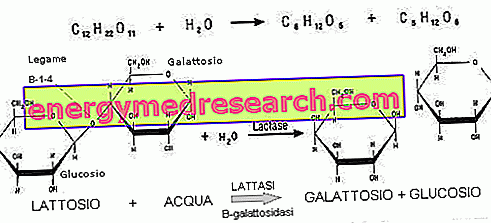What is the Lactase
Lactase is an enzyme used to digest the characteristic sugar of milk; in more technical terms this protein is responsible for the enzymatic hydrolysis of lactose in glucose and galactose:
lactose + H 2 O → galactose + glucose
Lactose is a sugar, a disaccharide typical of milk and its derivatives. In one hundred grams of cow's milk we find about 5 grams, while in breast milk the percentage content is close to 7% by weight.
Synthesis
In humans, the enzyme lactase is abundant in microvilli (brush border) of the small intestine, which as is known cover the intestinal villi increasing the absorbent surface. In this same place there are other disaccharidases, proteins with an enzymatic action similar to that of lactase responsible for the digestion of disaccharides such as sucrose (the normal cooking sugar) and maltose.
Optimal conditions for lactase activity occur at temperatures of 48 ° C and at pH close to neutrality (6.5).

Lactase belongs to the group of β-galactosidases, a family of hydrolytic enzymes that catalyze the cleavage of β-galactosides in their constituent monomers in the presence of water (β-galactoside is a simple compound with a sugar-bound part consisting of galactose) to another molecule through a glycosidic bond that is "under" the plane of the galactose molecule).
Lactose deficiency and intolerance
Lactase deficiency
A partial or absolute deficiency of lactase is responsible for one of the most common forms of food intolerance, manifested by intestinal bloating, flatulence and diarrhea following the ingestion of milk and lactose-rich foods.
Causes
Congenital lactase deficiency is quite rare and transmitted with autosomal recessive inheritance; it manifests itself from the first days of life with watery diarrhea, abdominal cramps, flatulence and abdominal distension; obviously the problem occurs with both artificial and maternal milk and can only be solved by using lactose-free or vegetable milks (such as rice or soy).
With growth, starting from 3-5 years, there is a progressive reduction of lactase activity, up to 90-95%. In adulthood, the digestive capacity of lactose can remain at high, medium levels or go down considerably to trigger an acquired intolerance. The residual activity affects the maximum amount of lactose that can be consumed without suffering from the aforementioned gastrointestinal disorders. In this regard, there are significant differences in the population resulting from polymorphisms of the gene that codes for the enzyme.
Temporary deficiencies in lactose activity also occur following diseases or conditions that damage the intestinal mucosa, such as viral gastroenteritis and celiac disease. Even not drinking milk for very long periods can make the body "forget" how to produce the enzyme, and vice versa; to summarize it is said that lactase is an inducible enzyme.
Lactase and Evolution
Adult hypolactasia is believed to be a primitive condition, then modified by the introduction of agriculture and pastoralism in the Neolithic period. Not surprisingly, the persistence of lactase in adulthood (considered in this sense the "true" anomaly) is typical of the geographical areas in which pastoralism has developed (such as Northern Europe); on the contrary, there is a high incidence of lactose intolerance in Southeast Asia and South Africa, areas where milk consumption is traditionally reduced or absent.



